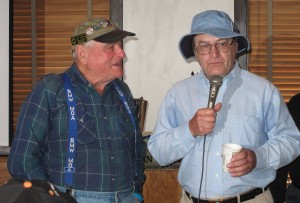
A LOT OF MILES: David Swisher and David Hough,
with millions between them...
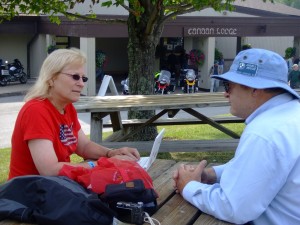
The author (left) interviews AMA Hall of Famer
David Hough.
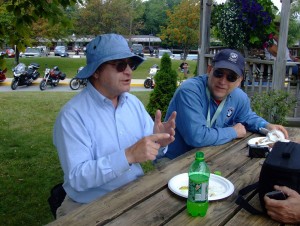
When Mr. Hough speaks, people listen...
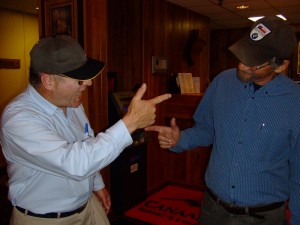
Two of the best: David Hough and Paul Glaves
share a light moment.
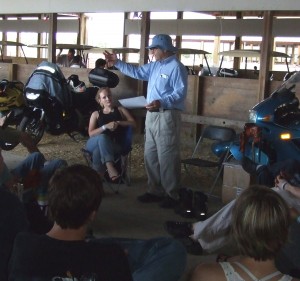
David works with Camp GEARS students at the BMW
MOA National Rally.
David L. Hough: An
Unlikely Hero
(BMW Owners News, December 2009)
At 72 years of age, David Hough might seem an unlikely hero. Don't tell that to Chris, the young rider who attended Camp G.E.A.R.S. only because of his parents' strong urging, but who ended up spending most of the 2008 Rally with David as his companion. Also don't tell the injured veteran that is now on three wheels after taking the new sidecar/trike curriculum designed by David. Don't even tell me. I discovered that I could ride over a dauntingly high dirt pass in Africa because David enchanted me with his writings about the magic of his ride over Swartburg Pass. Surely don't tell the AMA committee who finally honored David with a 2009 selection to the American Motorcyclist Hall of Fame.If on the fifth of December you feel that the earth seems more evenly balanced on its axis, it will be because a long overdue honor has finally been presented.
David started his motorcycling life in 1965 on a Suzuki 150, then moved up through a Yamaha 305 and a Honda 450, to a Moto Guzzi 750 Ambassador, all the while commuting to work by motorcycle. A friend in the BMW Riders of Oregon bought him a membership (#18259) in the BMW Motorcycle Owners of America. Shortly thereafter he bought a 1978 BMW. He flew it to Europe in 1980, toured for seven weeks, then flew it back home and crashed it just south of the Canadian border.
As David describes it, it was a real accident; the kind no one can plan for. A huge tilt out floor section of a mobile home came loose as he motored by. The loose section broke off and started to tumble. David attempted to avoid it by riding off the freeway, but the section flipped one last time and took him out. After landing in a blackberry bush, he ended up with a banged elbow and a broken clavicle. The bike was totaled. His sense of humor shines in the name he gave his new bike, "Blackberry Blue." His version of All the Gear All the Time at that time was a leather jacket, helmet, gloves and boots. And even then he knew, "We do have turns to crash so what you put on each day when you ride is what you're wearing when your turn comes up."
David and his wife, Diana, lived for many years on Bainbridge Island, west of Seattle. For the last 20 years, they have lived near Port Angeles, Washington, at Agnew on the north slope of the Olympic Peninsula. He has retired from Boeing where he started as a technical illustrator and later became a graphic illustrator. A natural progression found him developing video materials for flight crew training. One project of which he is especially proud described how a pilot could avoid volcanic ash.
His video tapes have been translated into many foreign languages. David worked for Boeing for 34 years. He knew who to call and who had the skills that were needed to improve airplane safety. He describes himself as a sort of "Sergeant Bilko" because of his skills in making things happen; never mind the rules. "Airplanes and motorcycles don't crash well," David said. "A pilot, like a motorcycle operator, needs the right skills to avoid a crash entirely because only avoidance ensures they don't get hurt."
After years of writing for Motorcycle Consumer News, David took some time out. His home was almost washed away by a sudden flood of the Dungeness River, and he needed time to build a new house on drier land. That was when Fred Rau tracked him down and asked that he write again, reminding David there were new riders who needed his expertise and that he knew David had more to say to the people who had been growing older along with him, so he continued writing for several more years, until he trained his replacement, Ken Condon.
Sandy Cohen, then editor of the BMW MOA Owners News, recruited him to share his expertise with BMW riders. He didn't want to just repeat his articles but safety articles must be right because lives depend on their accuracy. It takes a week to develop a whole new article, so David took his archived articles and rewrote them specifically for BMW riders, under the heading of "Between The Ears." Amazingly, no one complained about reading the same thing again!
Coffee with Dave, a meeting David first held at the 2000 BMW MOA International Rally at Midland, Michigan, was an attempt to share some of his expertise in a loosely structured gathering. The promise of coffee drew what was to David a surprisingly large crowd. Then, over the years when he added in pastries and bananas, WOW! He's introduced many "celebrities" and with the aid of sponsors such as Whitehorse Press and Road Gear, almost kept up with the demand. It's been an expensive proposition to travel and fund it, so in 2008 the BMW MOA Foundation stepped up to the plate to continue the tradition. David will be back in 2009 as the Rally will be close to his home.
Early on, motorcycle magazines had not had much in the way of safety articles, so when David began to fill that void, he quickly drew a following. A crowning point for him was receiving the BMW MOA Foundation Award for Contribution to Motorcycle Safety. It said to him that BMW riders really did value articles about riding skills. Modestly he explained that it was not simply an award for him personally, but for all who write about riding skills.
When he was designated a Friend of the Marque by the International Council of BMW Clubs, David felt that it recognized that we are all in this together and again validated the importance of writing about and training for safety. At that point, David laughed and commented, "Motorcycle Safety really is an oxymoron, like "military intelligence!" We don't ride to be safe. We ride to have fun."
He has received two awards from the Motorcycle Safety Foundation for his writings. Once more he modestly noted that it was another indication that the people involved recognized the importance of skills training and consistency. Though David acknowledges that Fred Rau has called him the "Grandfather of Motorcycle Training," in the early days the information was freely shared by everyone in the field. There had been no organized instructor preparation or written curriculum. David freely granted interviews and writers took furious notes and the ERC was created. It was based on materials including slides and discussion of simulated situations developed by David.
David recently had a potentially serious crash. In describing it he reflected on what he'd learned from it. It had been a wakeup call to him that his judgement was not what it should have been. He had been riding his R1150GS in the California desert in September, 2008. He was optimistic that he could do the ride on a loaded bike on a dirt road miles from civilization, alone. He knew he had the skills needed but he now feels it was a bad judgement call to be riding by himself. The front wheel hooked in a deep sand berm, spitting him and the bike off into the sagebrush at speed. When he awoke gasping for breath, he was in pain.
The crash resulted in injures to his shoulder and a cracked rib that did not allow him to pick up his bike and ride out. What he shared is that a rider must assume stuff will happen: not might, but will. To be prepared not only means to carry emergency equipment such as cell phone, water, and food, but also to have a plan that is well thought through. Any plan made by a calm reasable person at home has to be better than one made by an injured rider in pain. When a rider is upset and hurt, it's hard to make good decisions.
Right now assume a serious crash tomorrow, and think through contingencies so that you know what you will do. Write it down. It will help you to do the right things and think rationally.
An emergency checklist in your tank bag might include:
1. Tell someone where you are going.
2. Carry emergency supplies and some means of contacting help.
3. Carry personal and medical information on a thumb drive in your jacket pocket, including digital copies of your license, registration, and insurance.
4. Get out your "emergency checklist" to avoid panic.
5. Assess your injuries, and if necessary get to a hospital for a medical evaluation.
6. Think through what has really happened. Think through your options. Decide what is best for you.
7. If you must leave the motorcycle, make notes about its location.
David was able to get 911assistance and he used his GPS coordinates to pinpoint his location. The bill for the life flight helicopter was $38,000. He chuckled as he counseled, "You probably need a plan for how to deal with that, too!" For him the decision was to get to a hospital and get checked out, and then straighten the bike and continue his trip, but now he has a new Spyder as his primary vehicle.
There are two ways to learn. You can do it yourself by trial and error which can be painful and expensive. Or you can learn by watching other people and learning from their mistakes-that's called training. What David has done is to try to minimize the risk while recognizing that we can't totally avoid it. Life isn't safe. It's just an illusion that life is safe.
Regarding his induction into the AMA Hall of Fame Class of 2009 he had this to say: "For years and years and years the AMA has honored successful people in various classifications. They have never said much about riding skills or done anything in that vein. In fact, only a few motorcycle magazines have said much. When Fred Rau suggested readers should nominate me, there was no category, an indication of the value they placed on motorcycle safety training. That meant that there have been lots of MSF instructors, authors, track school instructors, dealers, course site administrators, and state safety coordinators who have done invaluable work and all with little recognition. They have helped people to become better riders and survive to ride more new motorcycles. I think Harry Hurt was probably the first to be recognized. So for me to be nominated feels like suddenly AMA says we need to honor and show appreciation to all who have been involved in riding skills training. It's really an 'atta boy' for all of those people."
One of the issues David is devoting his time to is skills training for drivers of three-wheeled vehicles. He doesn't believe that people with physical limitations should be excluded from motorcycling. Even someone with paralyzed legs can still ride with the assistance of that one more wheel. Many of today's motorcyclists don't realize that back in the 1920s, 9 out of 10 motorcycles had sidecars attached. Even today, motorcycles with sidecars and motorcycle-based trikes are defined as "motorcycles" by state laws.
David believes that if a veteran has lost the use of his/her legs, we should bend over backwards to help that rider to learn skills to ride three wheels safely. The problem he saw was that neither the Motorcycle Safety Foundation nor state programs offered three-wheeler training. So he wrote a book about the skills needed to pilot a sidecar. People wanted a training course, so David wrote that. Then there was a need for certified instructors, an Instructor Guide, and liability insurance. David tried to run a comprehensive program out of his wife's kitchen, but the needs for three-wheeler training were growing too quickly for that. Eventually the Evergreen Safety Council picked up the program and administers it nationwide. Finally, people who want it can get endorsement and subsidized training.
David ended on this note: "I'll be up on the podium for my induction into the Hall of Fame in Las Vegas in December. But I know that the AMA recognition isn't just about me. I think of myself as the "poster child" for all the people who have given their lives to helping riders become smarter and safer. Motorcycle skills training is a very tough job. It's hard physical and mental work.
So, I share the spotlight with instructors, rider coaches, and course site administrators. But I also give an "attaboy" to magazine editors, journalists, salespeople, and individual motorcyclists who have passed along skills and knowledge to less experienced riders. More than a few motorcyclists have reported back to me that they have loaned their own copy of Proficient Motorcycling to a new rider, and never got it back. They are proud that doing so probably saved a life. And I'm proud of being a part of all this."
David L. Hough has published:
Proficient Motorcycling, second edition, Bowtie Press
Street Strategies, Bowtie Press
More Proficient Motorcycling, Bowtie Press
Driving a Sidecar Outfit, Sidecar Safety Program
For more information on the Hall of Fame ceremonies, visit: http://www.motorcyclemuseum.org/
Photos: Paul Bachorz, Shannon Hough, Voni Glaves